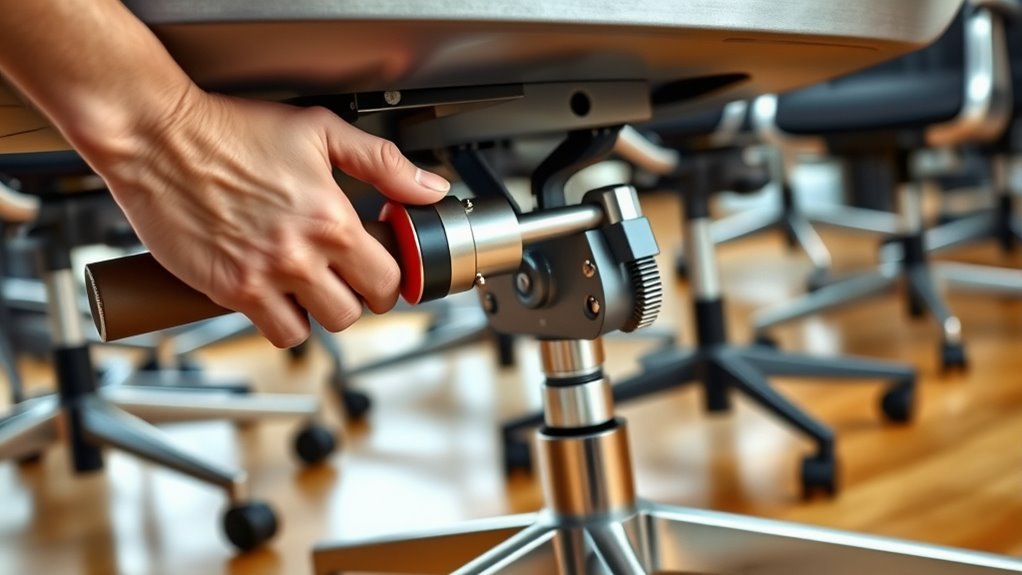Removing Chair From Office Chair Effectively
To remove your office chair seat effectively, start by gathering tools like screwdrivers and wrenches. Clear and organize your workspace, ensuring good lighting. Identify your chair’s mechanism—tilt, synchro-tilt, or pneumatic—and locate the screws or bolts securing the seat. Carefully loosen and detach them, watching for stuck parts or rust. Keep safety in mind to avoid injury or damage. If you want to master all steps and troubleshoot common issues, there’s plenty more to explore.
Tools Needed for Removing an Office Chair Seat

To remove an office chair seat, you’ll typically need just a few basic tools. First, a screwdriver set is essential since different seat attachment screws vary depending on mechanism types. You might encounter Phillips, flathead, or even hex screws, so having a versatile set gives you freedom from unnecessary trips to the store. Additionally, an adjustable wrench or pliers can help loosen bolts or nuts securing the seat attachment. Some chairs use clips or levers, so a flathead screwdriver or a putty knife might come in handy to gently pry these open. By preparing these tools, you’re ready to tackle various seat attachment styles confidently, giving you full control over your chair’s disassembly without frustration or delay.
Preparing Your Workspace for Chair Removal
A well-prepared workspace makes removing your office chair much easier and safer. Start by clearing the area around your chair to guarantee you have enough room to move freely. Good workspace organization means keeping tools and parts within reach but out of the way to prevent trips or accidents. Consider ergonomic considerations as you position yourself; you want to avoid awkward angles or heavy bending that might strain your body. Lay down a mat or towel to protect your floor and catch any small components that may fall. Make sure your workspace is well-lit so you can see screws and mechanisms clearly. By setting up a clean, organized, and ergonomic environment, you’ll simplify the removal process and protect your freedom to work comfortably and efficiently.
Identifying the Type of Office Chair Mechanism

Before you start removing your office chair, you’ll need to identify the type of mechanism it uses. Knowing the mechanism types helps you understand how chair adjustments work and how to safely detach parts without damage. Here’s what to look for:
- Tilt mechanism: Allows reclining and locking in different positions
- Synchro-tilt: Seat and backrest move in sync for ergonomic support
- Multi-function: Offers various adjustments like height, tilt, and armrest angle
- Height adjustment: Simple pneumatic lift for raising or lowering the seat
- Weight-activated: Automatically adjusts tension based on your body weight
Identifying your chair’s mechanism type frees you to approach removal confidently, ensuring you protect your chair and maintain its functionality.
Step-by-Step Guide to Detaching the Seat
Before you start detaching the seat, make sure you have the right tools, like a screwdriver or Allen wrench. Follow the seat removal steps carefully to avoid damaging any parts. Don’t forget to take safety precautions to protect yourself throughout the process.
Tools Needed
Getting the right tools ready will make detaching the seat from your office chair much easier. When you’re aiming for smooth chair maintenance or planning a seat replacement, having these essentials at hand frees you from frustration and wasted time. Here’s what you’ll need to confidently tackle the job:
- Screwdriver set (Phillips and flathead)
- Allen wrench or hex key
- Adjustable wrench
- Pliers
- Socket wrench set
Each tool plays an essential role in loosening screws, bolts, and fasteners that hold the seat in place. With this toolkit, you’re prepared to reclaim control over your workspace and extend your chair’s life effortlessly. Having these tools guarantees your seat removal process is straightforward and efficient, paving the way for a hassle-free chair upgrade or repair.
Seat Removal Process
To start detaching your office chair seat, you’ll want to locate and remove the screws or bolts securing it to the chair base. Use the appropriate tools to loosen each fastener carefully, ensuring you don’t strip them. Once all screws are out, gently lift the seat away from the base. This step is essential for effective seat maintenance, allowing you to clean or repair parts that affect chair comfort. Keep the hardware safe for reassembly or future adjustments. If the seat feels stuck, wiggle it slightly to free it without forcing damage. Removing the seat gives you the freedom to customize or replace components, ultimately enhancing your chair’s support and your workspace comfort.
Safety Precautions
After loosening the screws and lifting the seat, it’s important you follow safety precautions to avoid injury or damage. Wearing protective gear like gloves and safety glasses shields you from sharp edges and unexpected slips. Keep your workspace organized to prevent tripping or losing small parts. Here’s what you should do:
- Wear sturdy gloves and eye protection.
- Clear your workspace of clutter for better movement.
- Use a stable surface to place removed parts.
- Handle screws and tools carefully to avoid drops.
- Keep children and pets away from your work area.
Handling Common Obstacles During Removal
You might run into stuck parts or tight screws when removing your office chair. Knowing how to spot these obstacles and having the right tools ready can make the process smoother. Let’s go over how to handle these common issues efficiently.
Identifying Stuck Components
Although removing the chair from your office chair might seem straightforward, you’ll often encounter components that won’t budge easily. To regain your freedom from a stuck chair, start by identifying rust that may be locking parts together. Next, focus on checking alignment to guarantee nothing is jammed or out of place. Other common stuck components include:
- Corroded screws or bolts
- Warped plastic or metal parts
- Debris caught in joints
- Tight locking mechanisms
- Dried lubricant causing stiffness
Using Proper Tools
Two essential tools you’ll want on hand are a wrench and a screwdriver, as they tackle most bolts and screws that hold your office chair together. Knowing the right tool types for each component saves time and spares frustration. For example, a Phillips screwdriver is often needed for screws, while an adjustable wrench can loosen nuts and bolts. Don’t forget tool maintenance—keeping your tools clean, rust-free, and sharp guarantees they work smoothly when you need them most. Well-maintained tools give you control and freedom during removal, preventing damage to your chair or injury to yourself. By choosing and caring for the proper tools, you’ll handle common obstacles efficiently and confidently, making the removal process as straightforward as possible.
Managing Tight Screws
Proper tools make a big difference when dealing with tight screws, but even the right wrench or screwdriver can struggle against stubborn fasteners. To loosen screws that seem immovable, try these freedom-friendly tactics:
- Apply penetrating oil to break down rust or debris.
- Tap the screw lightly with a hammer to loosen its grip.
- Use a rubber band between the screwdriver and screw head for extra traction.
- Warm the screw gently with a heat gun to expand the metal.
- Alternate between tightening screws slightly before loosening to break their hold.
Don’t rush; patience helps you avoid damage and keeps you in control. Remember, tightening screws too much initially can cause this problem, so handle fasteners with care next time. You’ve got the tools and tricks to reclaim your office chair without frustration.
Safety Tips to Prevent Damage or Injury
Before you start removing the chair from your office chair, make certain you’ve cleared the surrounding area to prevent accidents. Safe handling is essential—wear gloves to protect your hands from sharp edges or unexpected slips. Use the right tools to avoid damaging parts or injuring yourself. If a screw or bolt feels stuck, don’t force it; try applying lubricant or gently tapping it loose. Always lift with your legs, not your back, to prevent strain. Keep children and pets away from your workspace to avoid distractions or accidents. By staying focused and following these injury prevention tips, you maintain control and freedom throughout the process. Taking these precautions guarantees the job goes smoothly without harming you or your chair.
Reassembling or Replacing the Office Chair Seat

Start by aligning the new or existing seat with the chair base, ensuring all mounting holes match up correctly. Whether you’re opting for seat replacement options or chair cushion upgrades, precision is key to restoring your chair’s comfort and functionality. Secure the seat firmly using the original screws or new hardware if provided. Remember, a well-reassembled seat guarantees your freedom to move without restrictions. Keep in mind:
Align your seat precisely and secure it firmly to restore comfort and ensure unrestricted movement.
- Double-check hole alignment before tightening screws
- Use quality cushions for enhanced comfort
- Replace worn padding for better support
- Test stability after assembly
- Consider ergonomic designs for long-term freedom
Frequently Asked Questions
Can I Remove the Chair Seat Without Any Tools?
You might be able to remove the chair seat without any tools, but it really depends on the chair design and how the seat attachment works. Some chairs use simple clips or snaps that you can release by hand, giving you the freedom to detach the seat easily. However, many office chairs have screws or bolts holding the seat in place, so tools are usually needed. Check your chair’s setup first to see what’s possible.
How Do I Know if My Chair Seat Is Detachable?
Sometimes, chairs like to keep their secrets close. To find out if your seat is detachable, take a gentle look underneath—check for visible screws or clips that hint at freedom in your chair design. If you spot these, your seat likely welcomes removal. If not, it might be one with a more permanent bond. Trust your curiosity; the design often whispers whether the seat’s meant to stay or can be set free.
Is It Safe to Remove an Office Chair Seat by Myself?
You can definitely remove your office chair seat by yourself, but you’ll want to follow safety precautions to avoid injury or damage. Make certain you have the right tools and clear workspace before you start. Taking care with chair maintenance not only keeps your chair in good shape but also guarantees your safety during the process. With a bit of care and patience, you’ll enjoy the freedom of fixing it on your own!
What Should I Do if the Screws Are Stripped?
If the screws are stripped, don’t worry—you’ve got options. Start by trying some screw extraction techniques like using a rubber band for extra grip or a specialized extractor tool. You can also drill a small hole to loosen the screw. These repair techniques can free you from frustration, letting you take control and fix the problem yourself without needing a pro. Keep your freedom intact and tackle it confidently!
Can Removing the Seat Affect the Chair’S Warranty?
Think of your chair’s warranty like a delicate pact between you and the maker—altering the seat might be seen as breaking that bond. When you modify the seat, you risk voiding warranty policies designed to protect original conditions. If you cherish freedom in customizing your space, check the fine print first; some warranties allow seat modifications, but many don’t. Always weigh your desire for change against preserving your chair’s official protection.






